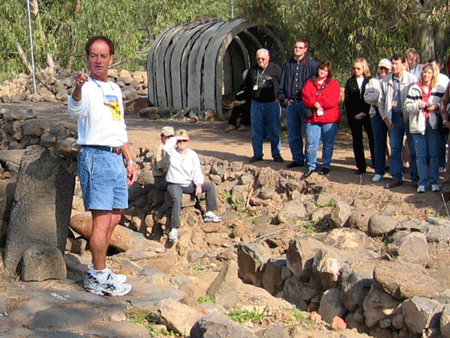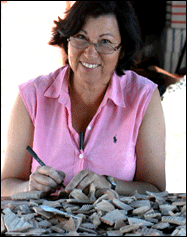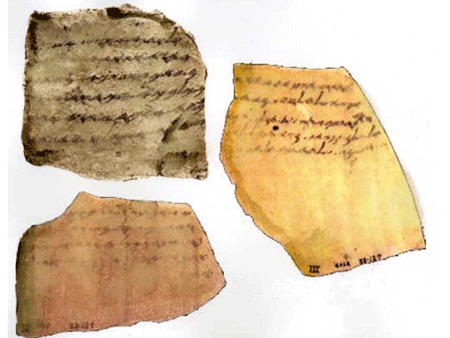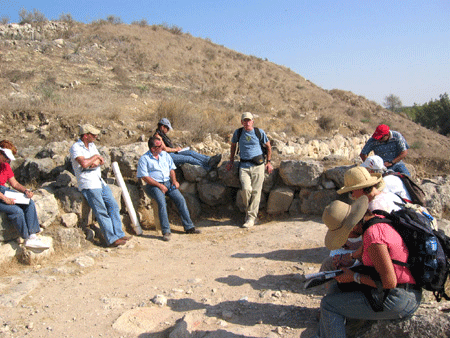- Has anyone ever found
an ostracon in the U.S.A.? And how rare is a
two-sided ostracon?
Kevin Callaghan, Michigan
|
|
This is a tough question!
First of all, let me explain that the word ostracon
comes from the Greek ostraka, referring to
potsherds or pieces of broken pottery that were used
as the writing surface to nominate people for
expulsion from ancient Athens. (Our English word
"ostracize" is derived from ostraka.) Broken
pottery was abundant and virtually free, so it
served as a kind of scrap paper. Papyrus, |
 |
| on the other hand,
was more high quality, |
Photo: Gath
bloggers |
|
but it was imported from Egypt and was |
"Goliath" ostracon from Tel
es-Safi (Gath) |
|
too costly for such transitory
purposes. |
|
|
|
The first question
about whether an ostracon has ever been found in the
U.S., I referred to my friend Dr. Jimmy Albright who
has dug over 20 years in the Holy Land and also on
the Chaco Canyon New Mexico Anasazi Indian site.
Here’s his reply:
|
"I do not know of any ostraca that have been
found in the U.S. I certainly have boxes of
shards from various Native American sites where I
have excavated from different time periods, some
with inscribed and painted decorations, but no
evidence of alphabetical letters. There are
some types of ceramics that have figure drawings
(humans, animals, plants, etc.) but nothing that
would be an inscription.
As far as can be determined Native Americans,
before the coming of the Europeans, did not have
any system of writing. There have been some
absurd, far-fetched assertions with little tiny
bits of so-called evidence that have been tossed
into the basket by far-out theorists. But I
do not know any that would have stuck."
|
|
 |
|
Photo: Gila
Yudkin |
|
Dr. Jimmy Albright showing where
he excavated at Bethsaida's city gate |
| |
|
 |
I thought
that an ostracon
inscribed on two sides was quite rare. I didn't
know offhand of any found in excavations in Israel,
so I asked Liora Freund whom I met during the
Ramat Rahel excavations.
Liora is a pottery expert who has worked on a
variety of digs for more than twenty years.
Coincidentally, it turns out that she worked
together with Dr. Albright on some of the same digs.
(Archeology is a small world in Israel!)
Liora checked with her mentor Professor Yitzhak Beit
Arieh who led the excavations at Tel Malhata and
Horvat Uza in the Negev. Here’s her reply: |
|
Pottery expert Liora Freund |
|
|
|
“Two-sided ostraca exist at Arad in the Arad letters
numbers 3, 8 and 39. And at Lachish, in the
Lachish letters numbers 3, 4 and 9. We also
have at a two-sided ostracon at Horvat Uza. I
hope it will be published within a year.
So, it
isn't so rare, although, not as common, as one-sided
ostracon.”
|
|
 |
|
Photo:
Courtesy of the British Museum |
|
Lachish letters: the right
ostracon is the reverse side of Lachish letter #3 |
|
|
| The
photo above shows three of the ostraca found in the
guardhouse at the entrance to Tel Lachish during the
1935 Starkey excavations. The ostracon on the
right is one of the two-sided ostracon that Liora
refers to. The photo below shows a group of my
colleagues sitting in one of the guardrooms where
the "Lachish Letters" (ostraca) were found. |
| |
|
 |
|
Photo: Gila
Yudkin |
|
A group of guides on-site where
the Lachish ostraca were found |
| |
| Below is
an aerial view of Horvat Uza in the
Negev where a two-sided ostracon was found in the
excavation led by Professor Yitzhak Beit Arieh. |
| |
|
 |
|
Photo:
Courtesy of Jimmy Albright |
|
Aerial view of Horvat Uza where a
two-sided ostracon was found |
| |
|
Read the story about one of my
tourists finding an ostracon at Qumran -- the first
piece of writing to be discovered at Qumran since
the site was excavated in the middle of the last
century in "Let's
inspect the ancient scroll of Isaiah." |

